Sergio Ruzzier’s Undeniable Conga Line
 November 5th, 2014 by jules
November 5th, 2014 by jules

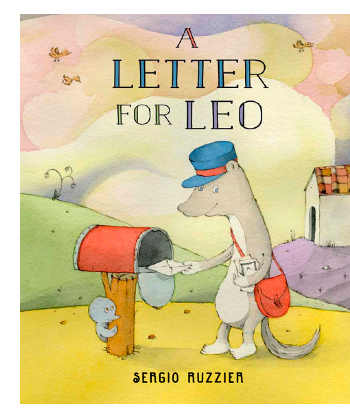 This morning, I’m talking to author-illustrator Sergio Ruzzier about his newest picture book, just released yesterday, called A Letter for Leo (Clarion, November 2014). Sergio also shares a bit of art and early sketches from the book.
This morning, I’m talking to author-illustrator Sergio Ruzzier about his newest picture book, just released yesterday, called A Letter for Leo (Clarion, November 2014). Sergio also shares a bit of art and early sketches from the book.
This is the story of Leo, a mail carrier who longs to get a letter himself. One morning, he finds a little blue bird, who pops out of a mailbox, in need of a home. The two become good friends, the bird even staying with Leo in his house. Since the bird’s response to everything is “cheep,” this is what Leo names him. Leo and Cheep become “a little family.”
But when Spring arrives, flocks of birds fly north. Cheep is ready to go too. There is a poignant goodbye (involving a “cheep” from Cheep and a “cheep” from Leo). Life goes back to what it was pre-Cheep, but Leo finally gets a letter. Cheep has written, and it’s my favorite picture book ending of 2014. The first time I read it with my own daughters we laughed and laughed, because the letter is composed entirely of “cheep”s.
Also, Cheep may or may not return to visit Leo, but I’ll leave that for you to discover on your own if you find a copy of this book.
Stories about friends coming and going — it’s a common theme in picture books, but no one does it quite like Ruzzier, given his lively, singular style and the rich visual narratives he creates. Booklist calls this one a “sweet, understated story set amid a wonderfully odd landscape.” I love that. This is a story both tender and laugh-outloud funny; Sergio pulls it off with ease — and with characters who leap off the page. Esther Averill once wrote that the “final test for any child’s book” is whether it can be “placed alongside the best for adults and hold its own.” I think Sergio’s books can.
Let’s get to it. I thank him for visiting today.
Jules: I gotta ask: You’ve mentioned previously that there’s a Sendak tribute in the book. Do you want to talk about it here, or do you still want to remain mum about it to see how many people can find it?
Sergio: The book just came out, and I don’t know how many people were able to read it yet. So I’d prefer to wait at least a few weeks. It’s a tiny tribute. I know you found it right away, but let’s see if others are as sharp-eyed. Have you looked under the jacket? There is another little surprise there.


(Click to enlarge)
Jules: I saw that! It’s very fun. I won’t say what it is but highly recommend that readers look for it when the book is out.
My girls and I also laugh every time we see the poor bird who flies into a mountain on the “When springtime comes” spread.


(Click each to enlarge)
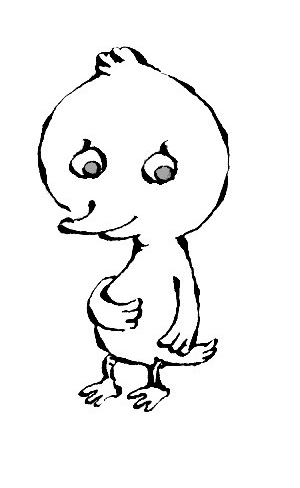 So, when did you start working on this one? Also, while we’re discussing it, I’ve always wondered what determines when a book’s cover gets something special on it, something different from the jacket? I always love to see that — say, an embossed cloth cover under the jacket or in this case, an illustration with a subtle change to it on the cover that brings a happy surprise. Does it come down to publishing funds, whether or not that’s done?
So, when did you start working on this one? Also, while we’re discussing it, I’ve always wondered what determines when a book’s cover gets something special on it, something different from the jacket? I always love to see that — say, an embossed cloth cover under the jacket or in this case, an illustration with a subtle change to it on the cover that brings a happy surprise. Does it come down to publishing funds, whether or not that’s done?
Sergio: From what I understand, it is both a budget issue and, at least for some publishers, a practical issue. They say that the jacket often gets detached from the book and lost, especially in the hands of little children, and if the case cover is too different from the jacket, then one might not find the book when one looks for it.
I am especially fond of three-piece bindings and embossed images and all that, so I’d be happy to run the risk.
That spread you are talking about (I am glad you noticed the falling bird!) was the first color drawing I did for the book. I worked on it while at the Sendak Fellowship, so three years ago in the fall of 2011. But I already had most of the story sketched out, at least an early version of it.

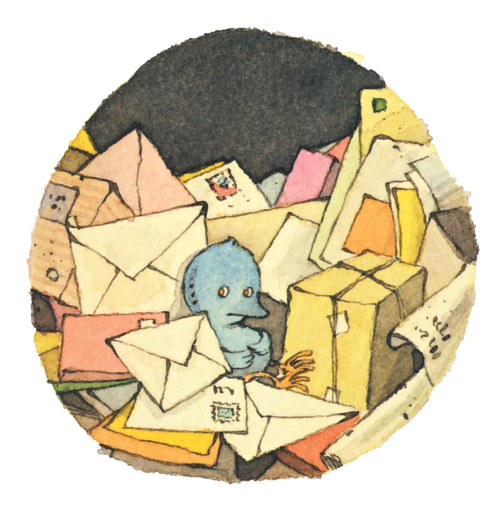
Jules: One of this book’s great successes, I think, is the emotional undercurrent. It gets me every time. I love the illustration for “Cheep is a big little bird now, and he is ready to go.” So much is conveyed there, and I love what you communicate in the window behind them (the strong, tall plant behind Cheep, and the wilting one behind Leo). Do you want to talk about building those layers of emotion?

Sergio: I had forgotten about those two plants! I had to go look at that picture to know what you were talking about. I usually tend to avoid oversentimentality in my stories, but sometimes it happens naturally, like here. Originally, I had a different sketch for that page: it showed Cheep preparing his own backpack, getting ready for his journey. But I thought it was too close to the text, something I try to avoid as well. I think the present scene is much subtler, with Cheep having his last meal while Leo doesn’t even try to eat, with the knot that surely is in his throat.


Jules: Yes. It’s such a knot-in-your-throat kind of pause in the story. It’s simply lovely.
A friend of mine sent me this quote recently, which is evidently from the August 24th issue of the NYT Book Review and written by Jennifer B. McDonald:
To withstand repeated reading, picture books ought to possess an infectious quality, like that gregarious guy at the party who, through sheer exuberance, can inspire everyone to join his conga line.
(You may be happy to know, given the storyline of A Letter for Leo, that my friend included that quote in an actual letter in the mail, ’cause YAY LETTERS.)
I feel like you’re inspiring us all to join your conga line. Your work has that quality. And your style is so distinctive. In the world of picture book-dom, nothing makes me sadder than seeing a new illustrator trying to mimic the style of well-known illustrators. I know this question sounds so cliché, but I’m going to ask it anyway, ’cause I’m curious to know how you’d answer: What advice would you give aspiring illustrators about finding their unique style/voice and sticking to it?
(And I just found the piece with that quote here online.)
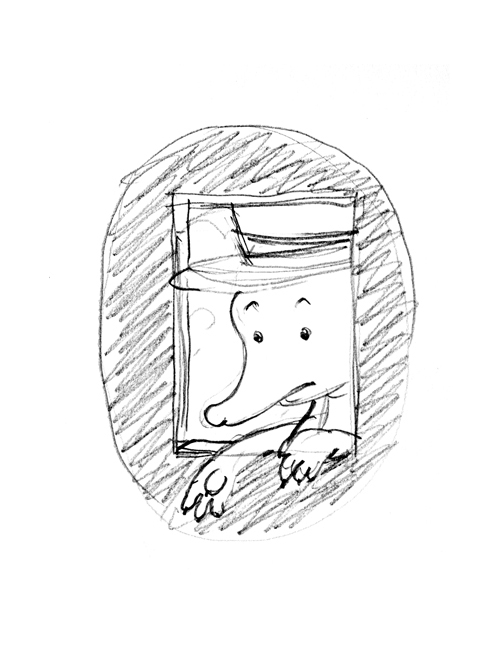

Sergio: I appreciate the conga line analogy, but you should know that when something like that happens at a party, I am the guy who hides in the bathroom.
It’s always so tricky to give generic advice! What I can say is that I have always been interested in visiting museums and old churches — and collecting art books. When you develop a personal, unique taste for art, whether it’s Romanesque architecture or Betty Boop cartoons, then you are probably on the good road to developing your own unique artistic style. The mimicking you are talking about is surely annoying, but what really baffles me is when a so-called artist doesn’t show any kind of cultural reference: you can be as technically skilled as you want, but your work will always be shallow and ultimately soulless. That, of course, doesn’t mean that your books won’t be hugely popular, but that’s a different issue.
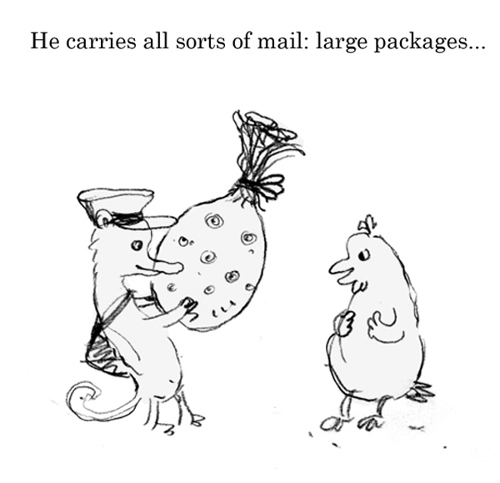
Jules: Would an example of this be the bocce in Leo? (I love that that’s there.)
It occurred to me that I’d like to ask you about your contribution to Masterful Marks: Cartoonists Who Changed the World (Simon & Schuster, September 2014), which I’ve seen. You did a tribute to Charles M. Schulz. Did you get to pick him? I know he’s been a big influence on your work.
Sergio: I was referring more to the form than the subject matter, but you are right: that applies to things like the bocce scene in Leo as well. I always try to slip into my books things that I am fond of, if it’s at least minimally pertinent and not forced. I hope this makes the whole story more genuine.
When Monte Beauchamp, the brilliant editor of BLAB!, called me to know if I’d be interested in collaborating to Masterful Marks, he also asked me to name my three favorite cartoonists. I said Schulz, Edward Lear, and Elzie C. Segar, if I remember well. (I have so many favorite cartoonists that’s quite impossible to select the top three, honestly.) Anyway, he assigned me Schulz, which was great and scary at the same time. I did a lot of research and then sketched the story, panel by panel, trying to be as faithful as possible, while giving my personal interpretation and being constrained to eight pages. I wish Schulz himself wouldn’t mind too much what I did with his life. I have always adored his work since I was a little kid.
Jules: I’m curious to know what you’re reading now and really love. I know that you recently read Alessandro Sanna’s The River (which the wonderful Cristiana Clerici is going to guest-post about soon here at 7-Imp). What else is firing you up?
Sergio: Alessandro Sanna’s work is always exquisite, but with The River I think he outclassed himself. It’s simply the best illustrated, most original picture book I’ve seen in a long time. And it’s really for any audience, as it should be more often with picture books. Not surprisingly, it’s Enchanted Lion that published it in the U.S.
I was lucky to see a preview of Rowboat Watkins’ Rude Cakes, which is coming out next spring: Watkins is a rare talent, both for his writing and his drawings, and I hope to see many more of his books in the near future.
Jules: I have to say: I just got a whole lot of enjoyment out of reading the “About” page at Rowboat’s site. Also, I love how he says the best picture books pull off “seemingly effortless feats of mind-scrubbing joy.”
I guess we can wrap this up, Sergio. One more question: What are you working on now? Anything new you’re allowed to talk about?
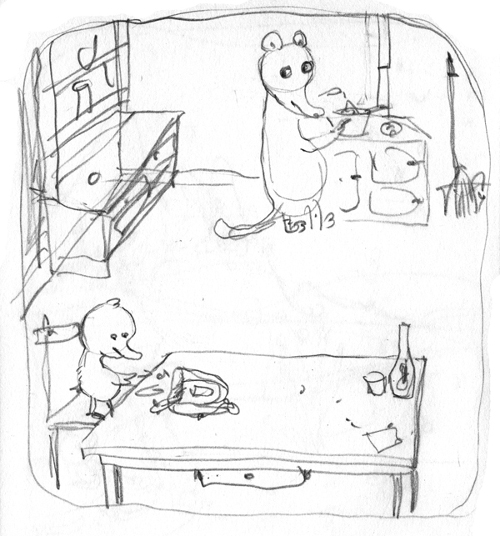
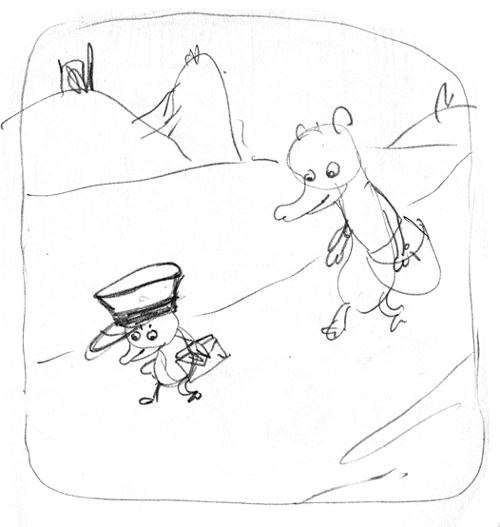
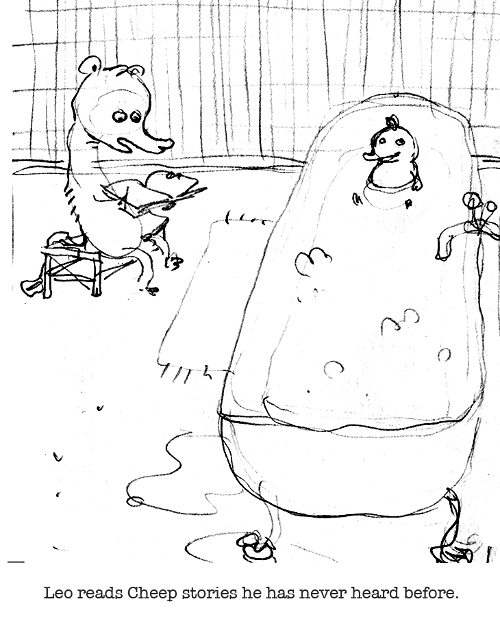
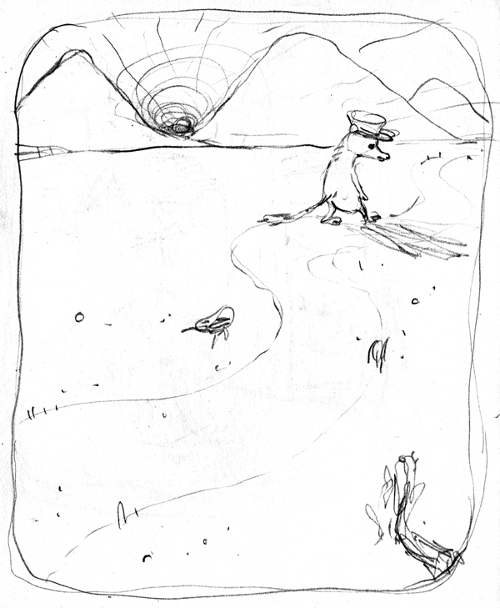
Sergio: These days I’m correcting the proofs of Two Mice, which will be published in the Fall of 2015. It’s probably my simplest book and, of course, the one that was the most complicated to write. I am very happy with the results, also thanks to my editor Dinah Stevenson and art director Christine Kettner at Clarion. It’s a very suspenseful adventure in the form of a counting book (only up to three). The size will be quite small, which I think is appropriate for little children or for any person with little hands.
Next Spring, my new collaboration with Eve Bunting comes out, two years after Have You Seen My New Blue Socks? The book is called Whose Shoe? and talks about a very honest and altruistic little mouse. I had a lot of fun doing the pictures, and it’s always a pleasure working on Eve’s stories.
I’m also doing the drawings for another text of mine that will be published by Chronicle in the Spring of 2016. The title is This Is Not a Picture Book!
Jules: I especially like it when you collaborate with Eve, who is such a talented writer. And the Chronicle book sounds intriguing.
Thanks for visiting and chatting. I do hope readers check out A Letter for Leo. If I ran the world, I’d make it required reading. (Well, required reading is no fun, but I’d do what I could.)
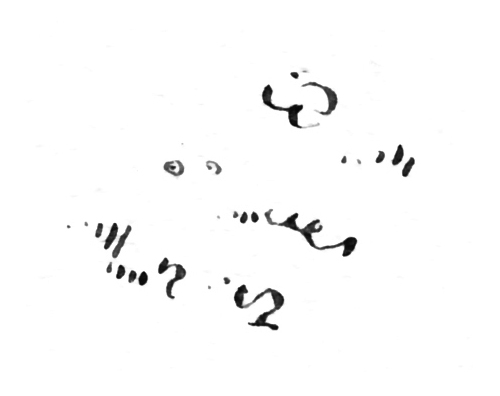
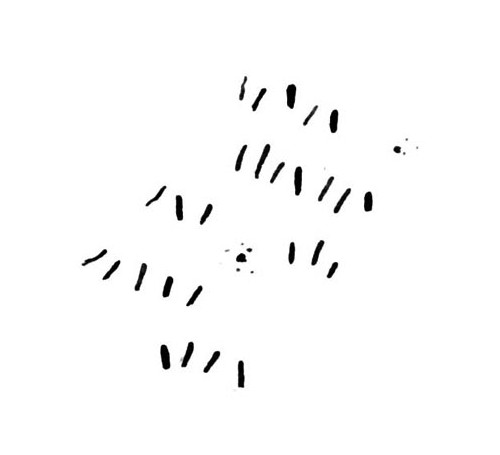
A LETTER FOR LEO. Copyright © 2014 by Sergio Ruzzier. Published by Clarion Books/Houghton Mifflin Harcourt, Boston. All images reproduced by permission of Sergio Ruzzier.

Loved hearing all about A Letter for Leo. It sounds really lovely and I can’t wait to see it. Thanks both of you. 🙂
I’m a sucker for books about mail and letters. Kudos!
Cheep, cheep, cheers all around! What a nice way to start the day.
Wendy, that reminds me: I should have named this post “Cheep Cheep Cheep Cheep Cheep: Cheep Cheep.”
Missed opportunities.
Cip cip (traduzione italiana) e complimenti!
Gosh, Jules and Sergio. I absolutely love this interview. I am still looking for the Sendak tribute so I am glad you did not reveal it.
I totally agree that no one does friends coming and going like Sergio Ruzzier. His friendship books are priceless.
[…] reference and a cutting from a final spread(Click second image to enlarge) Jules: Last time we chatted, speaking of Sendak, you talked about slipping in a tribute to him in A Letter for Leo. The last […]
[…] For original sketches and an interview, check out Jules Danielson’ post on the book. […]